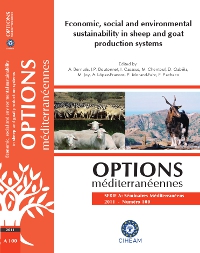| Article précédent | p. 133-137 | Article suivant |
Analyse de la durabilité de l'élevage de la race Barbarine élevée sous des conditions tunisiennes du système de production semi-aride
La Barbarine est la principale race ovine à viande en Tunisie. Avec ses deux écotypes dominants, la tête noire et la tête rousse, elle constitue 64 pour cent de l'effectif total des ovins. Connue pour son adaptation aux conditions climatiques difficiles, sa capacité à exploiter les pâturages pauvres ainsi qu'à surmonter les hautes températures, cette race participe à la conservation des zones marginales en particulier dans le centre et le sud de la Tunisie et joue un rôle socio-économique, notamment en faveur des petits agriculteurs (<5 ha). Cependant, sa productivité numérique n'excède pas 0,8 agneau / brebis / an. La production de viande est d'environ 12,5 kg / femelle / an. Les objectifs de cette étude consistent à analyser les performances de deux lots de brebis de race Barbarine à tête noire et à tête rousse, élevées dans le système de production semi-aride. Les résultats de l'analyse de 12 499 enregistrements (entre 2003 et 2008), ont démontré que les performances de croissance et de reproduction de cette race restent faibles ce qui pose des questions sur la durabilité et l'avenir à la fois de la race et du système de production dans lequel elle est élevée.
The main meat sheep breed in Tunisia is called the Barbarine. This breed is known for its two dominant strains: the Black and Red Heads. It represents 64 percent of the total sheep number. Known for its adaptation to the harsh climate conditions and its ability to take advantage of poorer pastures and withstanding high temperatures, this breed participates in the conservation of the marginal areas particularly in Central and Southern Tunisia and plays an important socio-economic role especially in favour of small farmers (<5 ha). However, the numerical productivity does not exceed 0.8 lamb/ewe/year producing around 12.5 kg of meat/female/year. The objectives of this paper are to analyse the productive and reproductive performances of the two Barbarine strains raised under a semi-arid Tunisian production system and of the factors that are influencing them. The analysis of 12,499 recordings between 2003 and 2008 showed that its growth and reproductive performances remain low which leads to questions about the future and the sustainability of the breed and of the production system where this breed is raised.
- [ Afficher ]
- [ Télécharger ]
- [ Exporter la citation ]
Vous pouvez télécharger la citation au format :
- [ Imprimer ]
-
Mots-clés
DURABILITE, PERFORMANCE ANIMALE, RACE (ANIMAL), RACE INDIGENE, SYSTEME D'ELEVAGE, SYSTEME D'EXPLOITATION AGRICOLE, TUNISIE, ZONE SEMI-ARIDECiter cet article
Brahmi A., Bouallègue M.A., Bouzaiène H., Khaldi G. Analyse de la durabilité de l'élevage de la race Barbarine élevée sous des conditions tunisiennes du système de production semi-aride. In : Bernués A. (ed.), Boutonnet J.P. (ed.), Casasús I. (ed.), Chentouf M. (ed.), Gabiña D. (ed.), Joy M. (ed.), López-Francos A. (ed.), Morand-Fehr P. (ed.), Pacheco F. (ed.). Economic, social and environmental sustainability in sheep and goat production systems. Zaragoza : CIHEAM / FAO / CITA-DGA, 2011. p. 133-137. (Options Méditerranéennes : Série A. Séminaires Méditerranéens; n. 100). 7. Proceedings of the International Seminar of the Sub-Network on Production Systems of the FAO-CIHEAM Inter-Regional Cooperative Research and Development Network on Sheep and Goats, 2010/11/10-12, Zaragoza (Spain). http://om.ciheam.org/om/pdf/a100/00801494.pdf



